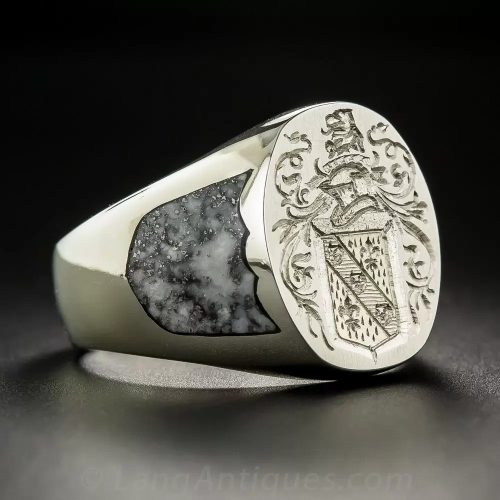
A signet ring features an intaglio gem, or decorative carving that is engraved with a monogram, coat of arms or, other heraldic or personal symbol. Throughout history, signets were used as seal rings to seal letters with the mark of the sender – in wax – in order to serve as an authentication mark.
At a time when only a few could write, seals which bore a distinguishing mark or badge – equivalent to a signature – that could be impressed on wax or clay, so as to stand out in relief as a mirror image, were essential for rulers, government officials and all engaged in business, to authenticate documents and establish the ownership of property. For convenience they were worn as rings on the finger, ready for use when needed.1
Signet Ring Timeline
c.3200 BC
c.3200 BC
c.2000 BC
c.1800 BC
c.1800 BC
c.1500-1400 BC
c.1500-1400 BC
c.1500 BC
c.1450-1425 BC
c.1152-1145 BC
c.664-404 BC
c.1400-1300 BC
c.600 BC
c.10th Century BC
c.650-400 BC
c.450-300 BC
c.450-300 BC
c.500 BC
c. 4th Century BC
c.300 BC
c.350-320 BC
c.350-320 BC
c.216 BC
c.100 AD
c.100-200 AD
c.100-200 AD
c.100 AD
c.300 AD
c.400-1100 AD
c.7th Century
c.6th-7th Century
7th Century
c.11th Century
c.9th Century
Until c.1350
c.1100-1200 AD
c.1200-1400 AD
c.1380 AD
c.1350-1500 AD
c.1350-1500 AD
c.1400-1600
c.1475-1525
c.1500-1600 AD
c.1554-1575 AD
c.1500-1650 AD
c.1600 AD
c.1700 AD
c.1780-1800
c.1791 AD
c.1788
c.19th Century
c.Mid-Victorian
c.19th Century
c.20th Century
Mesopotamia
Cylinder Seals
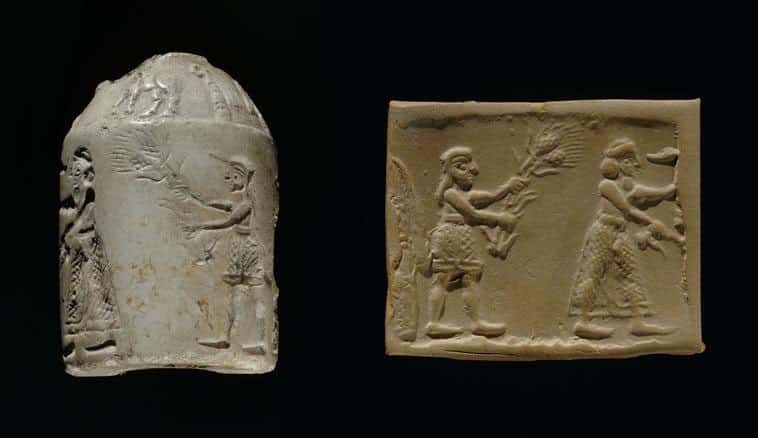
Signet Ring/Seal
Cylinder Seal of the Priest-King Uruk Period, c. 3200 BC
© R.M.N./C. Larrieu.u.
Bronze Age
RIngs
Most commonly made with a scarab on the top and hieroglyphs on the reverse identifying the owner.
These rings flipped over to reveal the signet side as necessary.
Ancient Egypt
Scarab Ring or Carved Intaglio.
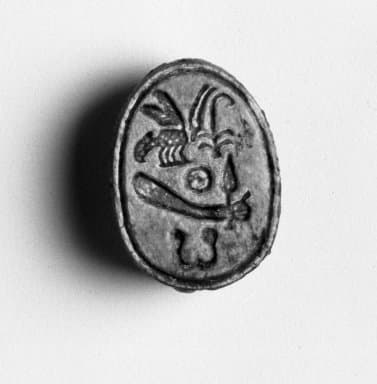
Signet Ring/Seal
Scarab of Amunhotep I. Steatite, Glazed, 7/16 x 11/16 in. (1.1 x 1.8 cm).
Brooklyn Museum, Charles Edwin Wilbour Fund, 44.123.142. Creative Commons-BY-NC.
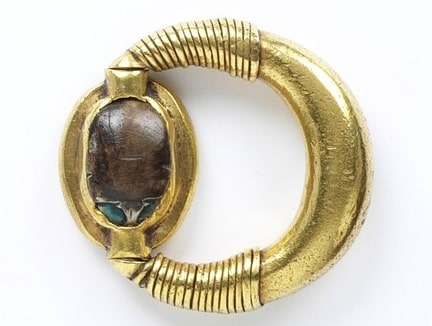
Signet Ring/Seal
Ancient Egyptian Steatite Beatle Ring.
© Victoria & Albert Museum Collection
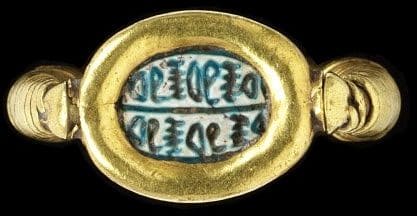
Signet Ring/Seal
Amuletic Inscription on the Reverse of the Previous Steatite Egyptian Ring.
Victoria & Albert Museum Collection.
Ancient Egypt
A Stirrup-Shaped Ring Made of Metal Came to Prominence. The Top was Engraved with Rank and other Hieroglyphs.
This Style Ring Served as a Visible Badge of Rank. Egyptian Signet Rings Continued to be Designed in this Style Until c.300 BC.
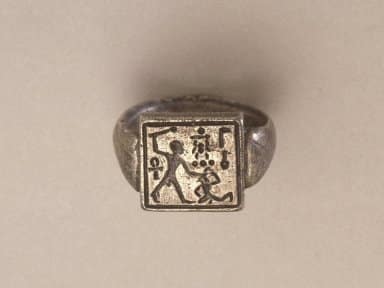
Signet Ring/Seal
Signet Ring Bearing the Name of Amunhotep II, 1450-1425 B.C.E. Silver, Other (Central design): 1/2 x 1/2 in. (1.3 x 1.3 cm).
Brooklyn Museum, Charles Edwin Wilbour Fund, 37.726E. Creative Commons-BY-NC.
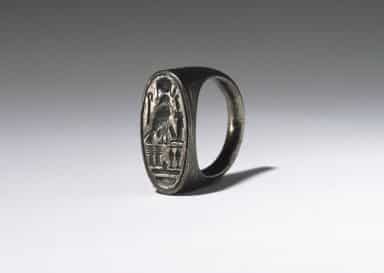
Signet Ring/Seal
Ring of Ramesses IV, ca. 1152-1145 B.C.E. Silver, 7/8in. (2.3cm).
Brooklyn Museum, Charles Edwin Wilbour Fund, 37.727E.Creative Commons-BY-NC.
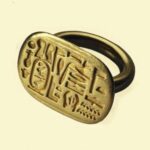
Signet Ring/Seal
Signet Ring, ca. 664-404 B.C.E. Gold, 13/16 in., 0.5 lb. (2.1 cm, 0.2kg).
Brooklyn Museum, Charles Edwin Wilbour Fund, 37.734E. Creative Commons-BY-NC.
Middle East
Signet Rings were Used in Sumer, Assyria, Babylon and Persia as a Signature Equivalent. Examples are Rare.
Greece
Gold Hoop, Flat Bezel, Engraved Seal or Engraved Gemstone.
Gold, Silver, and Bronze Signet Rings were Engraved with Natural Motifs and Depictions of Greek Masterpieces Began to Appear.
The Signet Style Ring from Greece Makes its way to Etruria and Thrives There. Again, Rings Flipped from Scarab Decoration to a FIgural Motif on the Reverse.
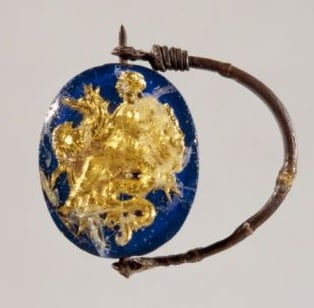
Signet Ring/Seal
c.10th century BC, Greece.
Getty Images.
Etruscans
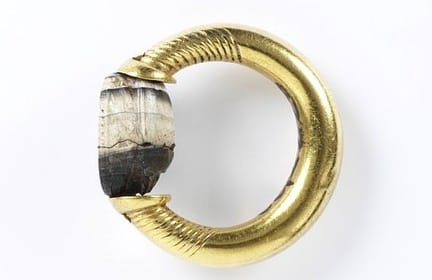
Signet Ring/Seal
Etruscan c. 450-300 BC (Side View).
Victoria & Albert Museum Collection.
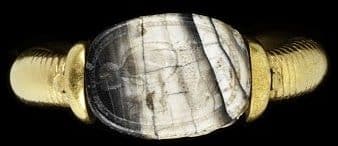
Signet Ring/Seal
Etruscan c. 450-300 BC (Reverse/Seal Side).
Victoria & Albert Museum Collection.
Rome
Large and Ornate with the Seal Engraved in a Gemstone.
Romans Wore Symbolic Rings
Senators: Iron Rings – Soon to be Replaced by Gold Rings
Ambassador Senators: Gold Rings
Later all Senators Wore Gold Rings
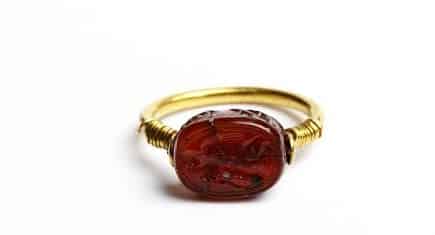
Signet Ring/Seal
Engraved Carnelian Signet Ring, c.4th Century BC.
Victoria & Albert Museum.
Helenistic Period
Rings Were Worn as Sign of Power and Respect (Some Were Given as a Memento).
Roman Knights and Patricians Wore Gold Rings
Later Soldiers and Born Freemen Could Wear Gold.
Signets Were Tossed into a Pile, One Drawn at Random, the Symbol on the Selected Ring was then Interpreted as an Omen – Either Good or Bad – Predicting the Outcome of a Contemplated Action.
Freedmen Wore Silver Rings (Sometimes they Cheated and Wore Blackened Gold so They had the Feel of Gold Without Breaking the Law.)
Iron Rings Were Worn as a Show of Respect During Mourning.

Signet Ring/Seal
Signet Ring Italy, c. 350-250 BC.
Victoria & Albert Museum Collection.
Victoria & Albert Museum Collection.
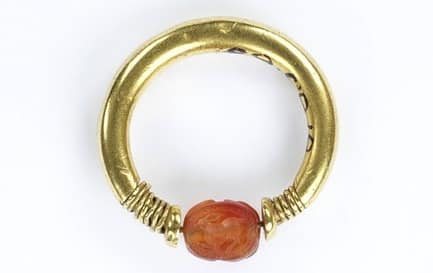
Signet Ring/Seal
Signet Ring Italy, c. 350-250 BC.
Victoria & Albert Museum Collection
Helemistic Period
Hannibal Defeats the Romans and Orders all the Rings Gathered from the Dead Roman Soldiers on the Battlefield, not as Wealth but as Proof of the Slaughter.
1st Century AD
Romans Began to Wear Gem Set Rings. Special Ivory Boxes Called Dactyliotheca “Ring Treasury” were Made to Keep Their Rings Safe.
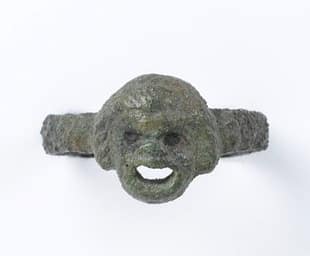
Signet Ring/Seal
Bronze Signet, Roman Empire c. 100-200 AD.
Victoria & Albert Museum Collection.
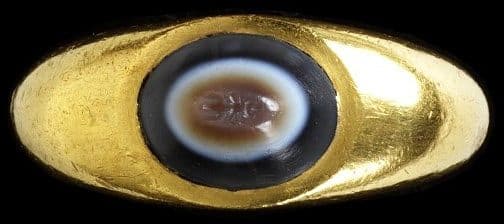
Signet Ring/Seal
Signet, Roman Empire c. 100-200 AD.
Victoria & Albert Museum Collection.
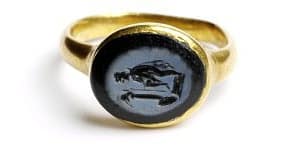
Signet Ring/Seal
Roman Empire c. 100 AD.
Victoria & Albert Museum Collection.
Victoria & Albert Museum Collection.
3rd Century AD
Christians Were Restricted to Signet Rings. Women Could Wear one Signet for Use in Their Household Duties.
Men were Allowed One Signet Worn On the Little Finger.
These Signets Were Only to Depict Christian Symbols and a Peaceful and Quiet Lifestyle. Pagan Gods and Themes of Debauchery Were Forbidden.
Byzantine Period
Religious Themed Signet Rings.
Gem engraving was a lost art form by this time and a return to carving symbols and letters on a gold ring became the fashion.
Severe and roughly engraved.
Often the bezel was of a cruciform design and contained symbols of Christianity.
When a carved gem is found in a ring of this period, it is usually a gem recycled from a ring of an earlier period.
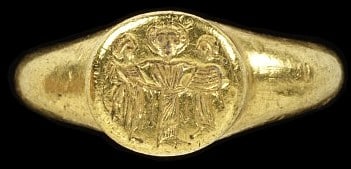
Signet Ring/Seal
7th Century Signet
Victoria & Albert Museum Collection.
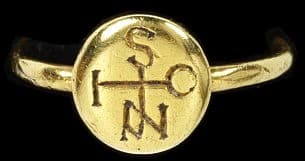
Signet Ring/Seal
6th – 7th Century Signet
Victoria & Albert Museum Collection.
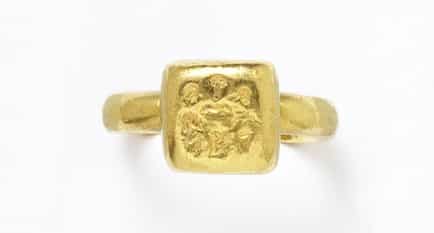
Signet Ring/Seal
7th Century Signet
Victoria & Albert Museum Collection.
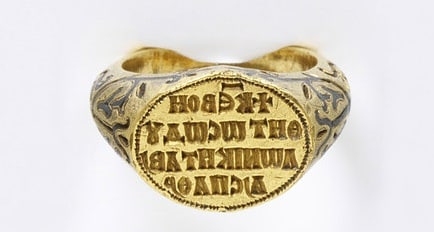
Signet Ring/Seal
11th Century Signet.
Victoria & Albert Museum Collection.
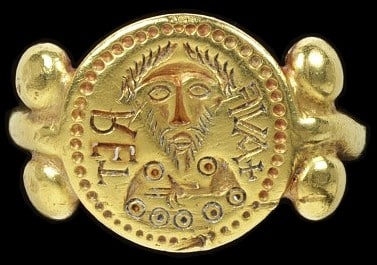
Signet Ring/Seal
9th Century Signet
Victoria & Albert Museum Collection.
Dark Ages
After the fall of Rome, many of the fine arts were no longer practiced.
Ring making continued using basic monograms with the occasional example carved with a portrait or inscription.
England
Mint marks on coins were often the reproduction of the local magistrate’s signet ring or that of the mint master.
Middle Ages
Rings were the most common jewel worn during the Medieval period, consequently, many examples have survived for us to study.
Rings became increasingly more ornately decorated and were sometimes used as a messenger’s credential.
They were worn on every finger, joint, stacked at the lower joint and often worn on the thumb.
There were rings designed to be worn over gloves and, as a result, they were quite large.
Red and blue stones were the most popular. Sometimes a color foil-backed crystal was used to simulate a particular gem or the reverse painted with bright colors so that they would not fade when pressed into wax.
Diamonds were set mostly in their natural crystal shape and were not widely used because they were difficult to cut.
Lombardic script, a rounded style, was used for engraved lettering up until about 1350.
The junction between the hoop and the ring’s bezel was often adorned with small dragon’s heads. c.1350-1400.
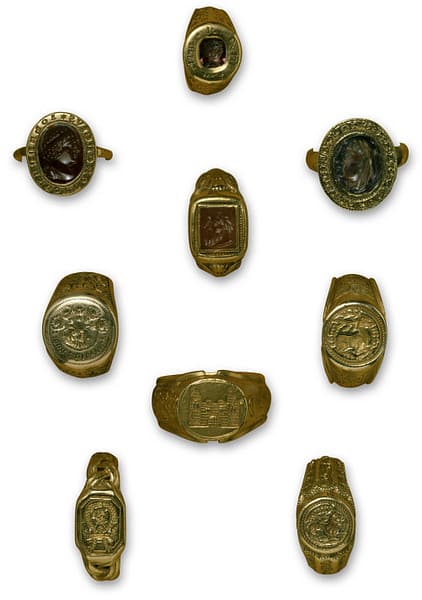
Signet Ring/Seal
Collection of Rings from Europe c. 1380.
Victoria & Albert Museum Collection.
Middle Ages/Renaissance
Gothic script, a spiky style of lettering, was popular for most engraving.
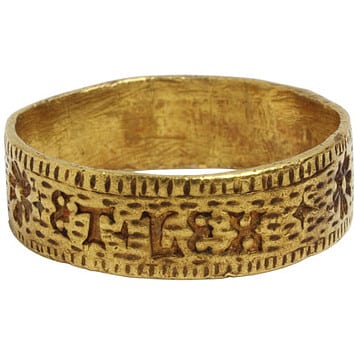
Signet Ring/Seal
Engraved Ring from the Second Quarter of the 15th Century.
Victoria & Albert Museum.
Renaissance
Landowners, merchants and other businessmen began to use seals to make an impression in the wax that sealed their contracts and documents. Plain, simple signet rings were popular for that purpose, usually worn on the index finger or thumb.
Heraldic themes became extremely popular. Often these rings were made in gilt bronze and could have colorful foil backings.
Wearing rings in Europe became a status symbol and unsuccessful attempts were made to restrict who could wear what metals.
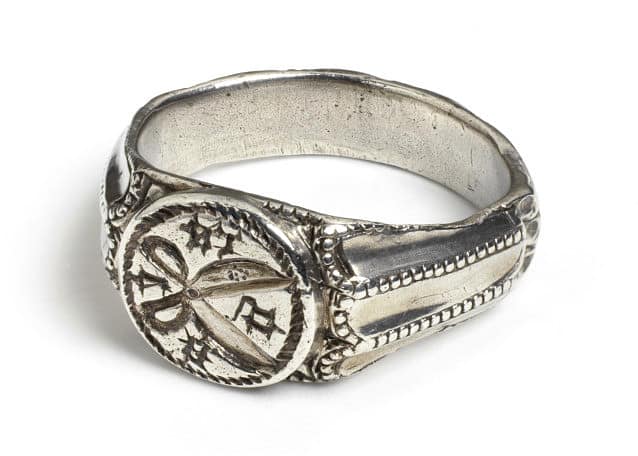
Signet Ring/Seal
Signet Ring with Scissors Symbolic of a Tailor c. 1475-1525, German.
Victoria & Albert Museum Collection.
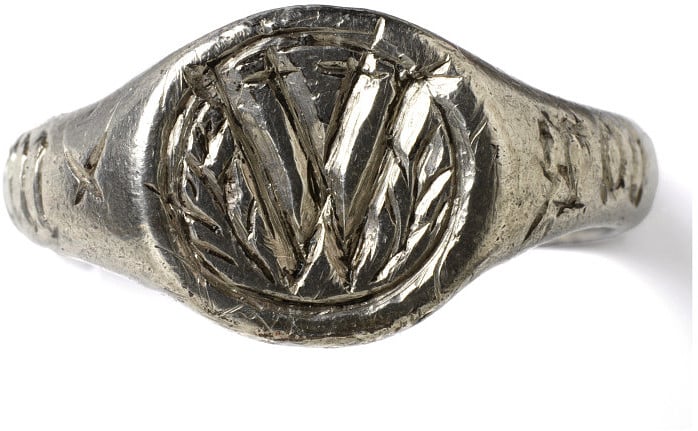
Signet Ring/Seal
Signet Ring with Initial W c.1450-1550, English.
Victoria & Albert Museum Collection.
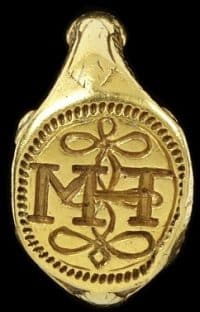
Signet Ring/Seal
Signet Ring c.1500-1600.
Victoria & Albert Museum Collection.
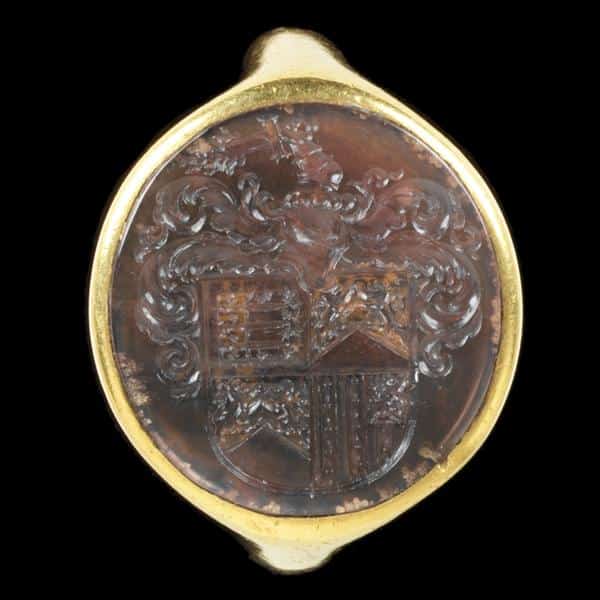
Signet Ring/Seal
Signet Ring c.1554-75.
Victoria & Albert Museum Collection.
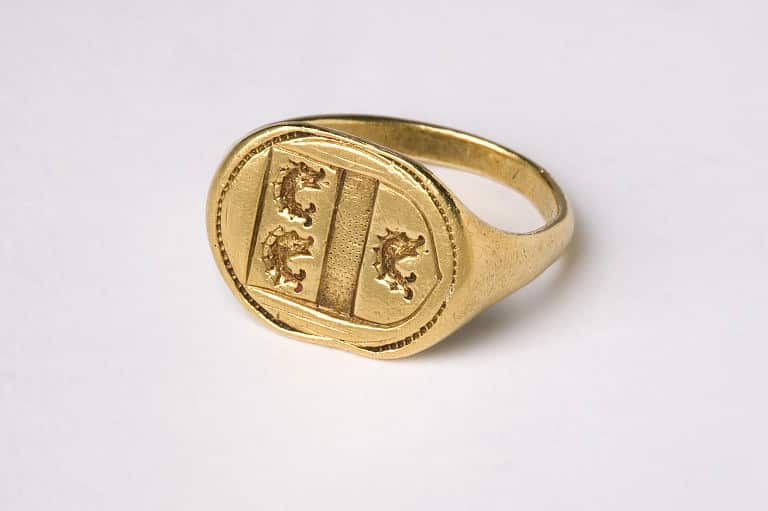
Signet Ring/Seal
Heraldic Signet Ring c.1500-1600.
Victoria & Albert Museum Collection.
Renaissance
Seal’s mounted not on a ring but with a handle began to appear. They could be worn on a chain with other “necessaries” and began to eclipse the signet ring in popularity.
18th Century
Used as an ornamental piece, sometimes with a faux cameo or intaglio.
Wealthy and prominent people collected rare engraved gems that had been created from ancient times through the Renaissance and they set them in elaborate rings
Miniature versions of ancient Rome began to be produced by a new generation of Roman gemstone carvers and engravers inspired by these collections. In addition, portraits of the famous and the infamous became the theme of the day.
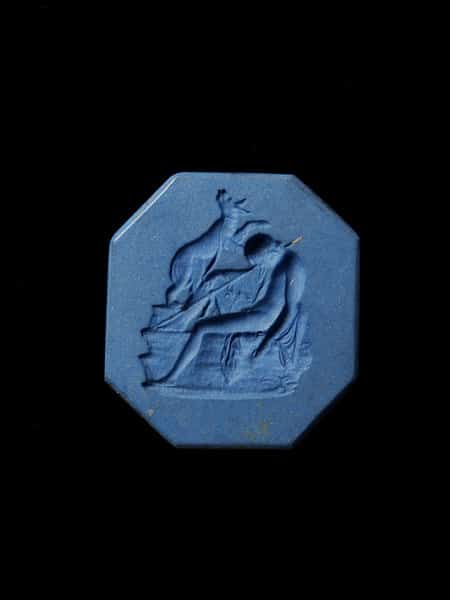
Signet Ring/Seal
Jasperware Intaglio c. 1780-1800, English.
Victoria & Albert Museum Collection.
Georgian
Only the very wealthy could afford such carvings so replicas of engraved gemstones were created by James Tassie using a custom glass paste formula. They were called “Tassies” and were set in every form of jewelry imaginable.
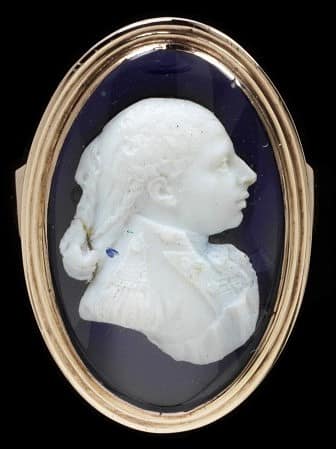
Signet Ring/Seal
Tassie Ring c. 1788.
Victoria & Albert Museum Collection.
Victorian Era
Desire for intaglios from ancient times began to wane but they were still available for purchase by tourists.
The signets of this era had a more romantic or nostalgic theme. Pride of heritage was reflected in elaborate rings with coats of arms or heraldic crests.
Initials carved in hardstone or gold became popular in the mid 19th century. Pio Castellani and his son Augusto lead a return to classical themes during this period.
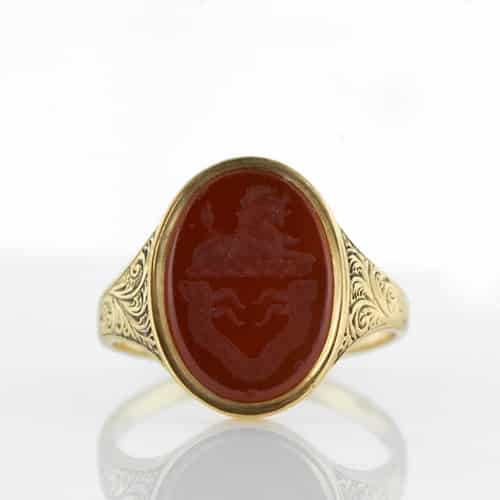
Signet Ring/Seal
Signet Ring with Reddish Orange Carnelian Intaglio of a Regal Lion with Scroll Motif Shoulders, Mid Victorian.
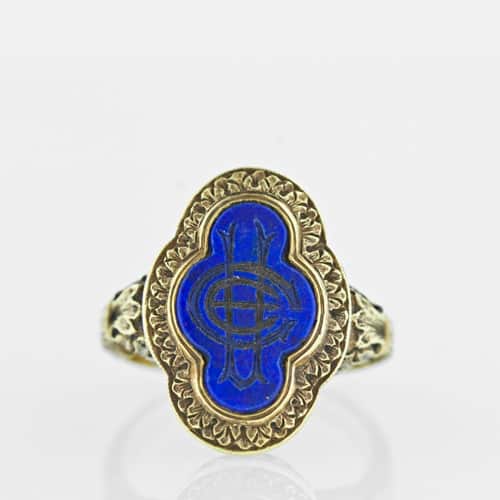
Signet Ring/Seal
Signet Ring with Neo-Classical Motifs, a Quatrefoil-Shaped Lapis Lazuli and a Cryptic Insignia.
Modern Era
Designed as a simple gold band with initials or monogram on the flat bezel.
Although rarely used for sealing documents anymore, the signet ring continued to be viewed as the “mark of the gentleman.”
Sources
- Campbell, Marian. Medieval Jewellery. London: V & A Publishing, 2009.
- Newman, Harold. An Illustrated Dictionary of Jewelry, London: Thames and Hudson, Ltd., 1981.
- Scarisbrick, Diana. Rings. London: Thames & Hudson Ltd., 2007.
Notes
- Scarisbrick, p.9↵